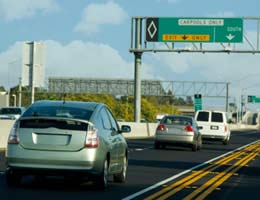Boost your Deductible
Generally, when someone decides on a deductible amount for his or her car insurance, he or she sticks with it. But increasing the amount you pay for fender benders is the best place to look when trying to lower your annual out-of-pocket expenses, according to the Insurance Information Institute.
Admittedly, it’s a gamble. A car wreck will cost you more this way, but if you and everyone else on your car insurance policy have a history of safe driving, it’s a way to save money. And if the threat of a big deductible payment worries you, put the money aside. Use your annual savings as an auto emergency fund so you’ll never be caught by surprise.
Carpooling
Joining a car pool has benefits beyond helping the environment. If you carpool with three other people, with each driving one- week shifts, you can cut the miles you drive by up to 75 percent. And the less you drive, the more you save on car insurance.
week shifts, you can cut the miles you drive by up to 75 percent. And the less you drive, the more you save on car insurance.
“Most companies track mileage,” says Art Scott, a retired insurance agent who worked for State Farm for 30 years. “Anything under 7,500 miles is considered the pleasure rate — and that’s the lowest. Up to about 13,000 miles is a medium rate, and anything over that is a higher rate.”
The amount you save will vary depending on several factors, but J. Robert Hunter, insurance director for the Consumer Federation of America, says the difference could be as much as 25 percent.
Buy What You Need
The car insurance you need when your car is brand new is often considerably different than what you need later on. Initial rates are generally higher, since you’re required to get both comprehensive and collision coverage if you took out a car loan to pay for the vehicle. Comprehensive pays for the repair or replacement of your car from damage that doesn’t result from an accident, and collision covers damages if you’re in a wreck.
Once it’s paid off, most people forget to save money by exploring their car insurance options. Check the value of your car through the Kelley Blue Book or NADAguides.com. You might have more collision insurance than you need. And in some cases, it might be worth dropping it entirely, especially if your car is an older model.
“It’s often smart to drop collision on older vehicles,” says Mike Barry, spokesman for the Insurance Information Institute. “Comprehensive is so inexpensive, and you’re giving up a coverage you might need — that’s worth hanging on to, though.”
Among the reasons you might need comprehensive coverage: damage from storms, vandalism and theft.
Combine Your Policies
If you’ve got your car insurance through a different company than you did your homeowners insurance or renters insurance, you may be paying more than you should. It’s called “multilining” in the industry. It means that by combining policies with a single company, you can stack discounts and save money.
may be paying more than you should. It’s called “multilining” in the industry. It means that by combining policies with a single company, you can stack discounts and save money.
Car insurance is the biggest risk for policy writers. You’re more likely to get in an accident or have your car stolen than to have something catastrophic happen to your house. By combining policies, you lower some of the insurance company’s risk.
“Multiline is where they make their money, rather than just picking up a loser like auto insurance,” says Scott. “The more lines (of insurance that insurance companies) can get, the more they’re willing to give discounts for it.”
Audit Your Driving
Have you changed jobs recently? Maybe you’ve moved to an area where your favorite stores are a lot closer? Keep an eye on that odometer to save money. Just like with carpooling, reduced driving mileage means reduced car insurance rates, says Scott, the retired insurance agent. But people often don’t reach out to their insurance agents when their residence or driving habits change, and they end up sticking with unnecessarily high rates.
Consider a Tracking Device
If you know you’re a careful driver, you might save money with a new car insurance policy from Progressive Casualty Insurance Co. called MyRate. A small wireless device is attached to your car, letting the company monitor your driving habits, including distance, most frequent travel times and driving habits, such as sudden stops or speeding.
After the first year, you could save as much as 60 percent, according to Progressive. But you will be sacrificing some privacy for the savings. And in some states, such as New Jersey, if the company doesn’t like your driving habits, it could raise your rate by up to 9 percent.
Concerns about the device’s intrusive nature have slowed the rollout of MyRate in several states. In Pennsylvania, Progressive ultimately withdrew its filing to introduce the coverage, says Melissa Fox, deputy press secretary for the Pennsylvania Insurance Department.
Pay Your Bills
Your timeliness in paying your bills may not seem like it has anything to do with your driving abilities, but it’s something car insurance companies pay attention to. If you’ve got a good credit report, it’s worth checking with your agent to see about a discount and save money.
“Many insurers use credit-based insurance scores,” says Barry. “It’s a contentious issue in certain state houses … (but) insurers will say their studies show that if you’re responsible in your personal life, you’re less likely to file claims.”
There are other ways to get car insurance discounts. Older drivers who complete adult driver safety programs can get premium reductions, while many insurers offer discounts for teens who maintain a 3.0 grade point average in school.
H/T Source: Bankrate, Inc.


